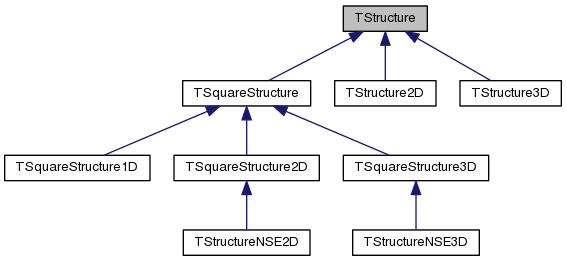|
| | TStructure () |
| |
| | TStructure (int n, int N_entries, int *col_ptr, int *row_ptr) |
| |
| | TStructure (int nRows, int nCols, int N_entries, int *col_ptr, int *row_ptr) |
| |
| | TStructure (int nRows, int nCols) |
| |
| | ~TStructure () |
| |
| int | GetN_Rows () const |
| |
| int | GetN_Columns () const |
| |
| int | GetN_Entries () const |
| |
| int | GetHangingN_Entries () const |
| |
| int * | GetKCol () const |
| |
| int * | GetHangingKCol () const |
| |
| int * | GetRowPtr () const |
| |
| int * | GetHangingRowPtr () const |
| |
|
void | setN_Rows (int n) |
| | set member variables. Careful, this can produce inconsistencies!
|
| |
|
void | setN_Columns (int n) |
| |
|
void | setN_Entries (int n) |
| |
|
void | setKCol (int *p) |
| |
|
void | setRowPtr (int *p) |
| |
| void | SortRow (int *BeginPtr, int *AfterEndPtr) |
| |
| void | Sort () |
| |
| int | index_of_entry (const int i, const int j) const |
| | find the index of a given entry More...
|
| |
| TStructure * | GetTransposed () |
| |
| TStructure::TStructure |
( |
| ) |
|
generate the matrix structure, both space with 2D collection
generate the matrix structure, both spaces are 2D
| TStructure::TStructure |
( |
int |
n, |
|
|
int |
N_entries, |
|
|
int * |
col_ptr, |
|
|
int * |
row_ptr |
|
) |
| |
generate a (square) matrix structure, all arrays are already defined
| TStructure::TStructure |
( |
int |
nRows, |
|
|
int |
nCols, |
|
|
int |
N_entries, |
|
|
int * |
col_ptr, |
|
|
int * |
row_ptr |
|
) |
| |
generate the matrix structure, all arrays are already defined
| TStructure::TStructure |
( |
int |
nRows, |
|
|
int |
nCols |
|
) |
| |
Generates an empty nRows*nCols Structure for a Zero-Matrix
| TStructure::~TStructure |
( |
| ) |
|
destructor: free all used arrays
destructor
| int* TStructure::GetHangingKCol |
( |
| ) |
const |
|
inline |
| int TStructure::GetHangingN_Entries |
( |
| ) |
const |
|
inline |
return number of matrix entries (hanging nodes part)
| int* TStructure::GetHangingRowPtr |
( |
| ) |
const |
|
inline |
return array HangingRowPtr
| int* TStructure::GetKCol |
( |
| ) |
const |
|
inline |
| int TStructure::GetN_Columns |
( |
| ) |
const |
|
inline |
| int TStructure::GetN_Entries |
( |
| ) |
const |
|
inline |
return number of matrix entries
| int TStructure::GetN_Rows |
( |
| ) |
const |
|
inline |
| int* TStructure::GetRowPtr |
( |
| ) |
const |
|
inline |
return a new structure for a transposed matrix If this is an object of a derived class (e.g. TStructure2D, TSquareStructure), then the number of active degrees of freedom is not taken into account. The returned TMatrix is really the algebraic transposed matrix.
return a new structure for a transposed matrix
| int TStructure::index_of_entry |
( |
const int |
i, |
|
|
const int |
j |
|
) |
| const |
find the index of a given entry
If the (i,j)-th entry is not in the sparsity pattern, -1 is returned. This is how this function can be used to check whether an entry is in the sparsity pattern.
- Parameters
-
| i | row of entry to check |
| j | column of entry to check |
| void TStructure::Sort |
( |
| ) |
|
sort rows
sort numbers within each row
| void TStructure::SortRow |
( |
int * |
BeginPtr, |
|
|
int * |
AfterEndPtr |
|
) |
| |
sort one row
sort one row [BeginPtr, AfterEndPtr)
return a structure for the matrix-matrix-product A*B
if A and B are matrices with structures 'strucA' and 'strucB', this function computes a structure for the product C = A*B
- Parameters
-
| strucA | structure of left factor |
| strucB | structure of right factor |
Comparision Operator.
It is not explicitly checked if the arrays are the same, only the integers are compared.
| int* TStructure::HangingKCol |
|
protected |
in which column is the current entry (hanging nodes part
| int TStructure::HangingN_Entries |
|
protected |
number of matrix entries in hanging nodes part
| int* TStructure::HangingRowPtr |
|
protected |
index in HangingKCol where each row starts
in which column is the current entry
| int TStructure::N_Columns |
|
protected |
| int TStructure::N_Entries |
|
protected |
index in KCol where each row starts
The documentation for this class was generated from the following files:
















 1.8.5
1.8.5